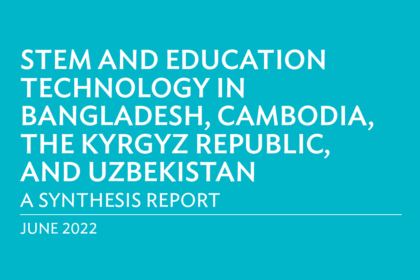
This publication focuses on the state of science, technology, engineering, and mathematics (STEM) education and education technology (EdTech) in four developing member countries (DMCs) of the Asian Development Bank (ADB): Bangladesh, Cambodia, the Kyrgyz Republic, and Uzbekistan. It presents studies conducted from May 2020 to May 2021, along with situation analysis reports on EdTech and describes the state of information and communication technology (ICT) in the general education subsectors (primary and secondary) of the four DMCs. It discusses findings from the country studies, identifies gaps and potential intervention areas, and provides policy and intervention recommendations.
STEM Education
Findings from a survey of STEM teachers yielded a wealth of data on 11 subscales:
(i) syllabus in teaching
(ii) assessment
(iii) textbooks
(iv) preservice teacher training program
(v) inclusion of ICT
(vi) students’ interest
(vii) professional development programs
(viii) pedagogy
(ix) project work
(x) innovations in education and laboratory
(xi) design and technology workshops
Based on the survey samples, perception ratings by the teachers on the state of STEM education in their schools and countries are not high. In addition, further findings were gathered from the qualitative responses of teachers to four open-ended questions:
(i) three aspects that teachers are already good at
(ii) three challenges they face in teaching STEM in school
(iii) two improvements that schools can make to improve teaching and learning in their STEM subjects
(iv) one way in which the country can become strong in STEM education
A survey of school leaders also yielded a wealth of data on five subscales:
(i) school leadership
(ii) school improvement
(iii) relationship with national education authorities
(iv) relationships with other stakeholders
(v) professional development of teachers
Perception ratings by school leaders on the effectiveness of education in their schools and countries are not high. The qualitative responses of school leaders to four open-ended questions also highlighted further findings. The questions focused on the following:
(i) three things that are working well in schools
(ii) three challenges faced by schools
(iii) two improvements schools can make to improve teaching and learning
(iv) one way in which countries can become strong in education
Examination of internet resources as well as confirmatory discussions with stakeholders indicate the absence of science centers set up in the classical manner. Also absent are nongovernment organization (NGO)-based scientific academies and scientific societies in the four DMCs. This shows a big gap as well as an opportunity to identify and develop complementary resources that could effectively contribute to institutionalizing STEM education through a network of critical stakeholders in the DMCs, as done by other successful countries.
A comparison of STEM education in the four DMCs with Finland and Singapore shows that there are several areas for improvement, mainly in relation to preservice teacher education, teacher professional development, STEM education practices, the presence of external providers of STEM education, the establishment of a high bandwidth access to internet in schools, and the promotion of research activity levels of teacher education institutes.
In light of the findings, suggestions to improve the state of STEM education in the four DMC include the following:
(i) Improve students’ interest levels in science and mathematics.
(ii) Ensure that STEM teachers attend regular in-service courses as part of their professional
development and enhance latest developments on STEM education.
(iii) Improve preservice and in-service teacher education in STEM subjects to enhance
pedagogical practices that contribute to improvement in student learning outcomes.
(iv) Further develop the research expertise of academic staff at teacher education institutes.
(v) Establish science centers to popularize STEM.
(vi) Form NGO-based scientific societies to further boost activity levels of STEM education.
(vii) Promote integrated STEM education initiatives through low-cost initiatives.
(viii) Significantly increase the internet bandwidth in schools.
Given ADB’s recognition of STEM education in improving pedagogical practices and learning outcomes, particularly of girls and disadvantaged and marginalized students, some suggestions for further work are also provided. Most of these relate to organizing workshops in relation to the proposed suggestions for improving the state of STEM education in the four DMCs, organizing various courses for preservice teacher educators and other trainers of STEM subjects, forming local committees with ADB representatives to oversee the implementation of some recommendations, and establishing and strengthening knowledge partnerships with centers of excellence with proven expertise in STEM education, and providing some seed funding to jump-start the suggested initiatives.
The two surveys on STEM teachers’ views about STEM and school leaders’ views of the education system have good psychometric validity and reliability. As a next step, these can be used to map the state of STEM education in other DMCs, with some fine-tuning in phrasing to suit local contexts.
EdTech
With the pervasive adoption and usage of ICT in every sphere of life, mastery of those technologies becomes a fundamental requirement for work in the 21st century. Technologies in education systems or so-called “education technologies” (EdTechs) are providing new opportunities for students, teachers, education officers, and families to enhance learning and equity-at-scale by creating engaging, inclusive, and individualized learning experiences.
ADB commissioned the studies on Bangladesh, Cambodia, the Kyrgyz Republic, and Uzbekistan to gain insights on the current state of EdTech in the general education sector and how it is adapted and used in facilitating the learning outcomes and 21st century employability skills. The studies aimed to fill gaps in knowledge (including the early developments associated with the coronavirus disease [COVID-19] pandemic) as well as map the existing body of knowledge to inform ADB’s five-pillar assessment framework. The studies are also geared toward developing methodologies for collecting information on the digital learning readiness of DMCs.
The five domains and dimensions of the research framework are the following:
(i) Infrastructure. The situation related to the state of the ICT infrastructure in the country, including its quality and accessibility to students. Four key components are evaluated: internet connectivity, devices, power networks, and broadcasting.
(ii) Government. The situation related to enabling legislation and government policies and actions (laws, policies, funding, plans, strategy, and road maps) to support the role of EdTech in enhancing education outcomes. It specifically looks at the following four areas: policies and funding, curriculum, education performance measurement, and preservice training.
(iii) Schools and teachers. The situation related to the capacity of schoolteachers and school administrators. The key areas studied are teacher capacity in EdTech; in-service training; equipment and software in schools; and governance (school policies, budget, monitoring for quality learning outcomes).
(iv) Parents and students. The quality of home or community environment in terms of facilitating or enabling the achievement of student learning outcomes. These include digital literacy of students, connectivity and devices at home, online access to curriculum content, digital skills, and community support.
(v) Providers. The insight is about the quality of EdTech systems and providers and education sector partnerships. It includes a review of learning management, e-learning systems, online content, integrators, developers, and sponsors.
The most important finding was the need for shifting to a technology-inclusive ecosystem approach that would enable EdTech to transform education, away from the piecemeal and siloed approach seen in many DMCs. EdTech is not about simply replacing the current face-to-face mode of teaching and learning. It is about digitizing teaching, learning, and administrative processes while promoting adaptive or personalized learning through a collaborative process that combines the power of technology (data and evidence), with creative pedagogical practices that support learning and equity at scale.
It is paramount for educationists to cross boundaries and interact with a variety of stakeholders because success in EdTech delivery depends on understanding and implementing beyond the normal capacity of one government agency. EdTech requires new ways of envisioning education systems and enabling interaction between students and teachers, and curricula must be adjusted as content, delivery style, and organization also transform.
Read the full article here.


